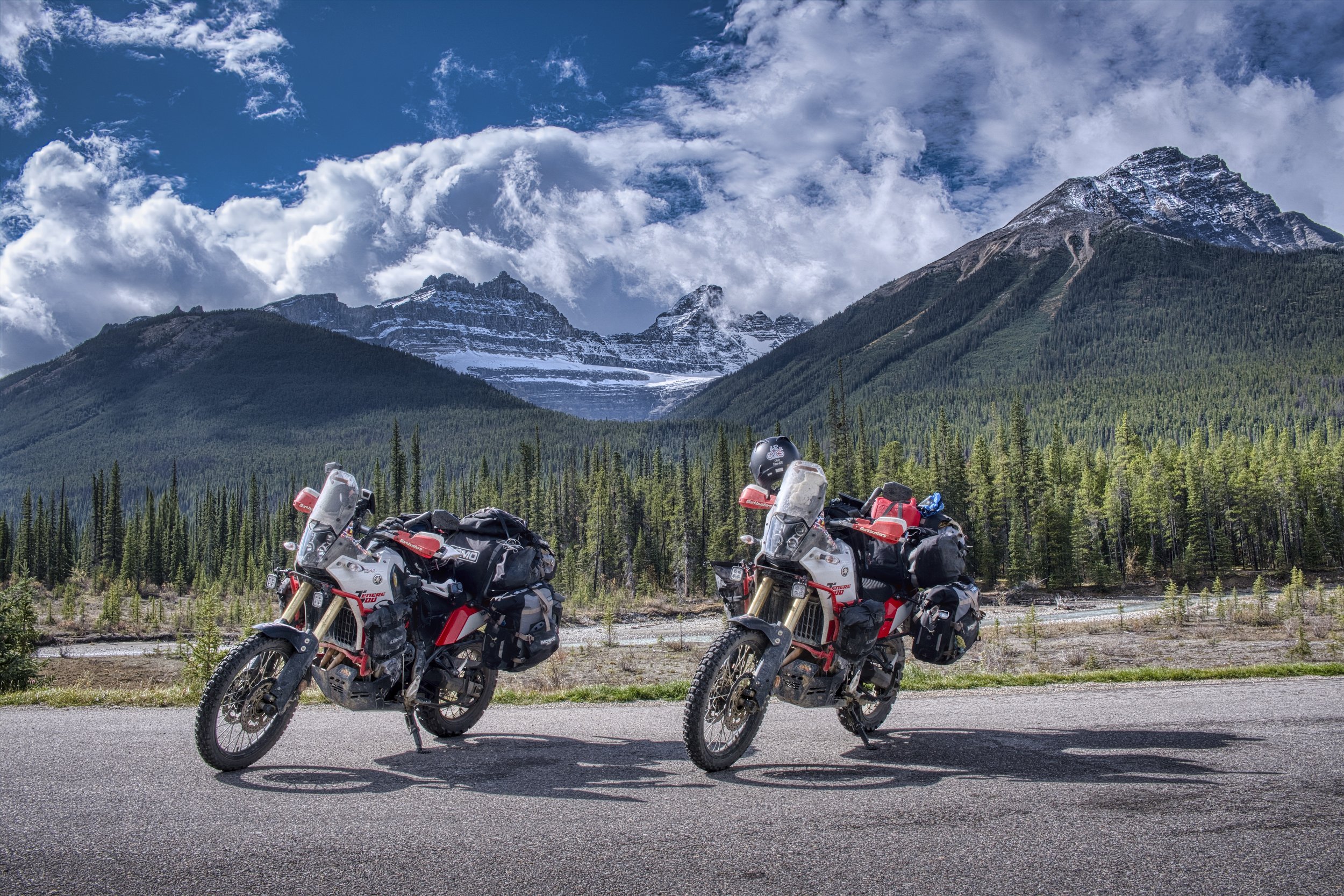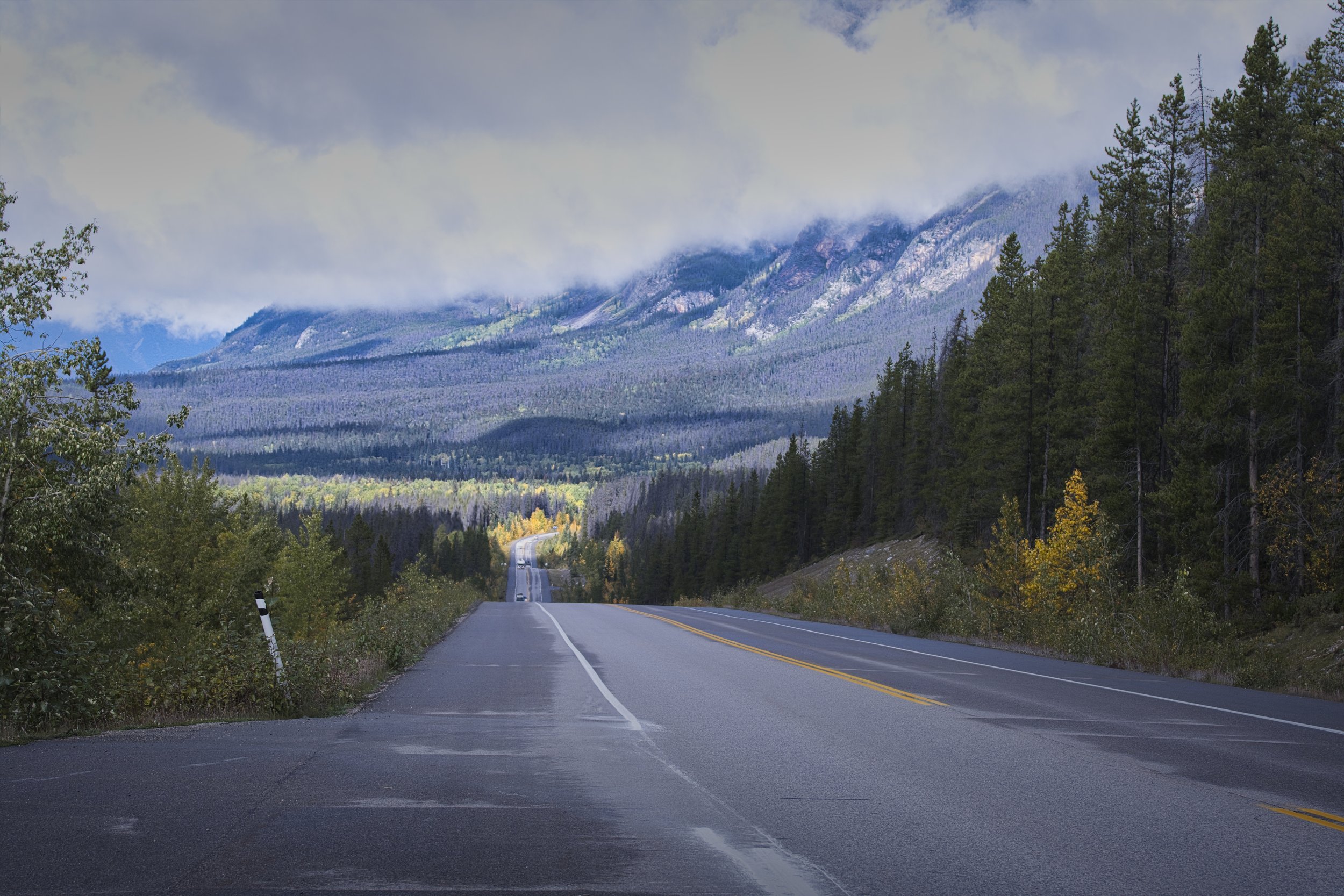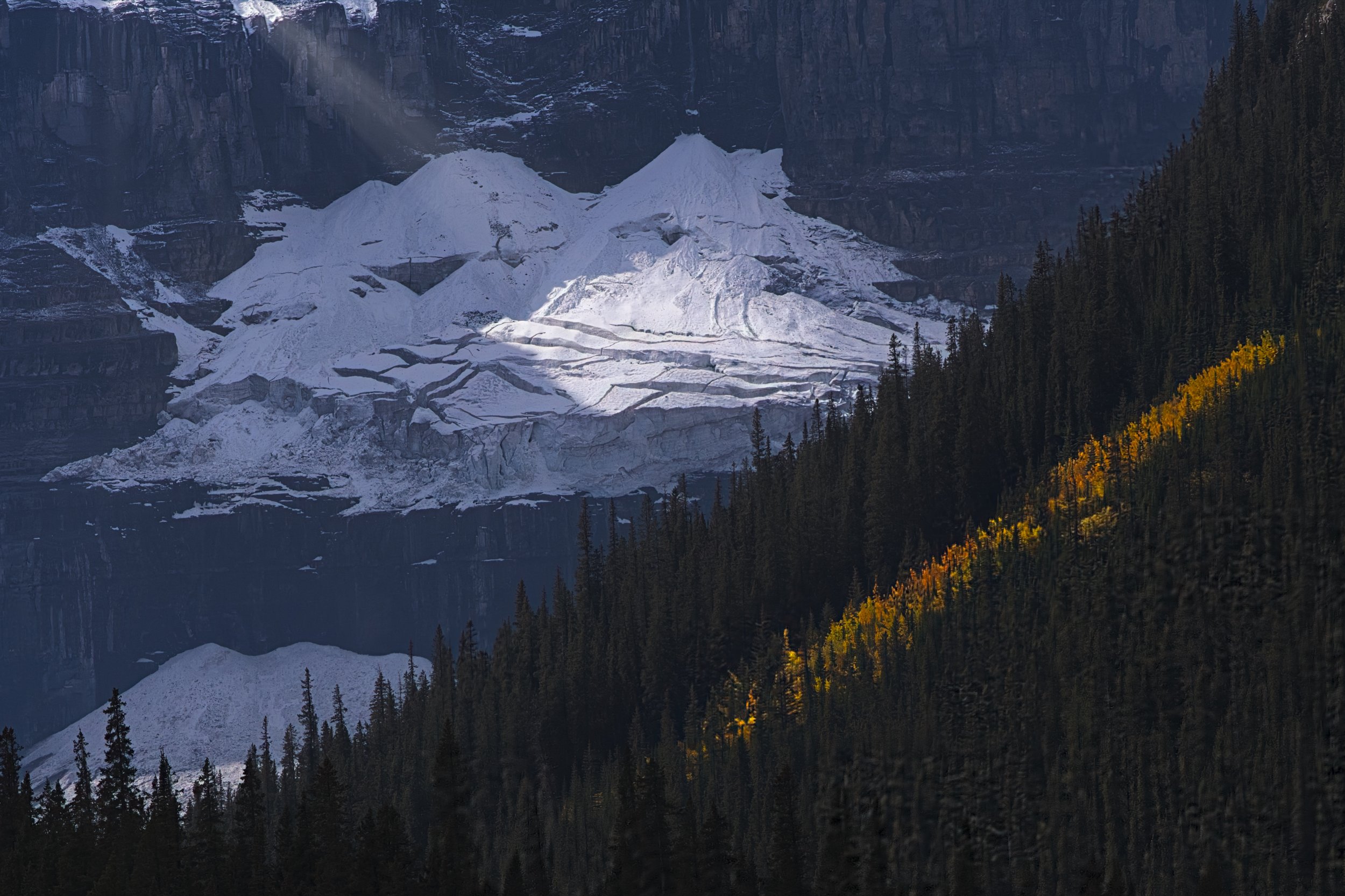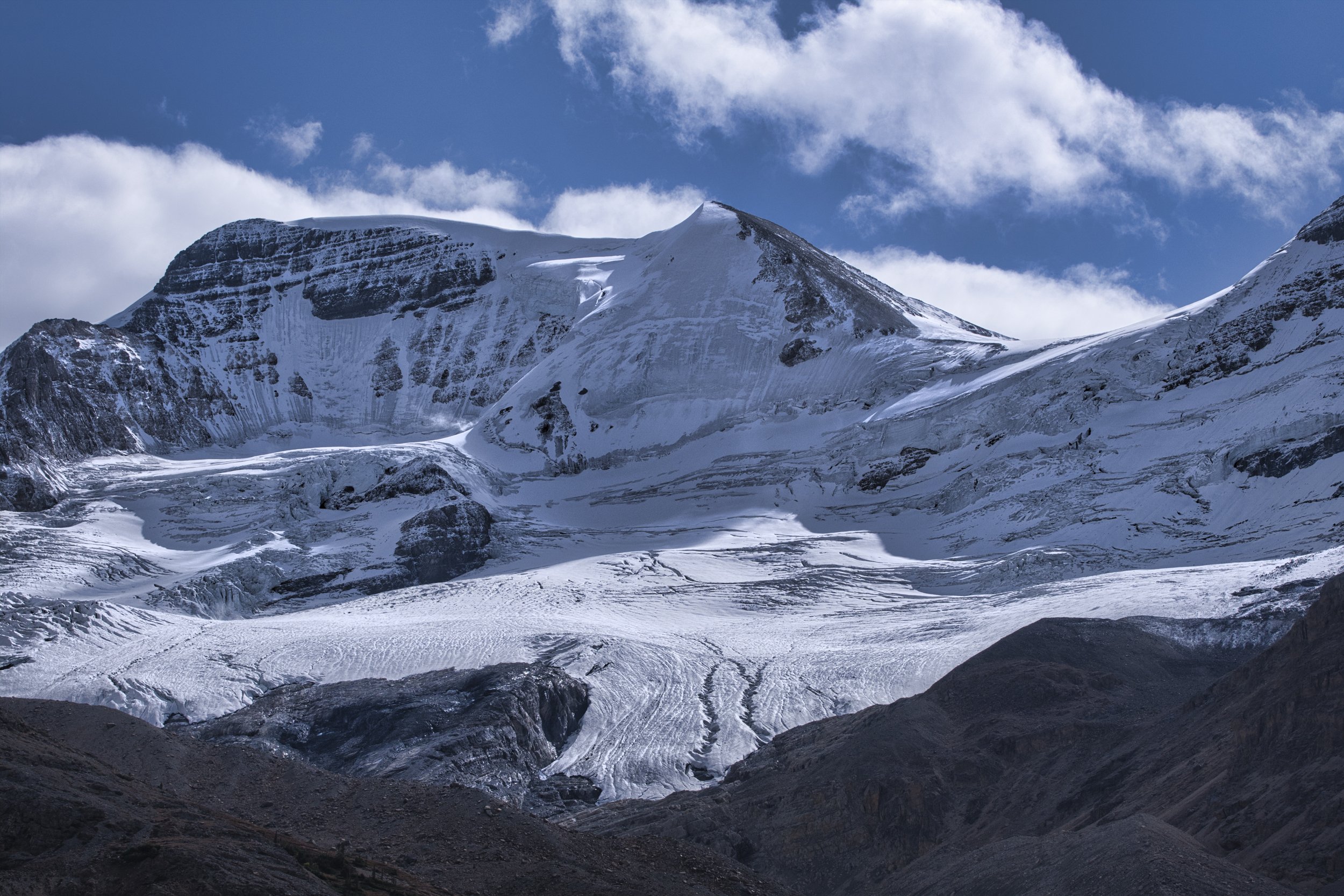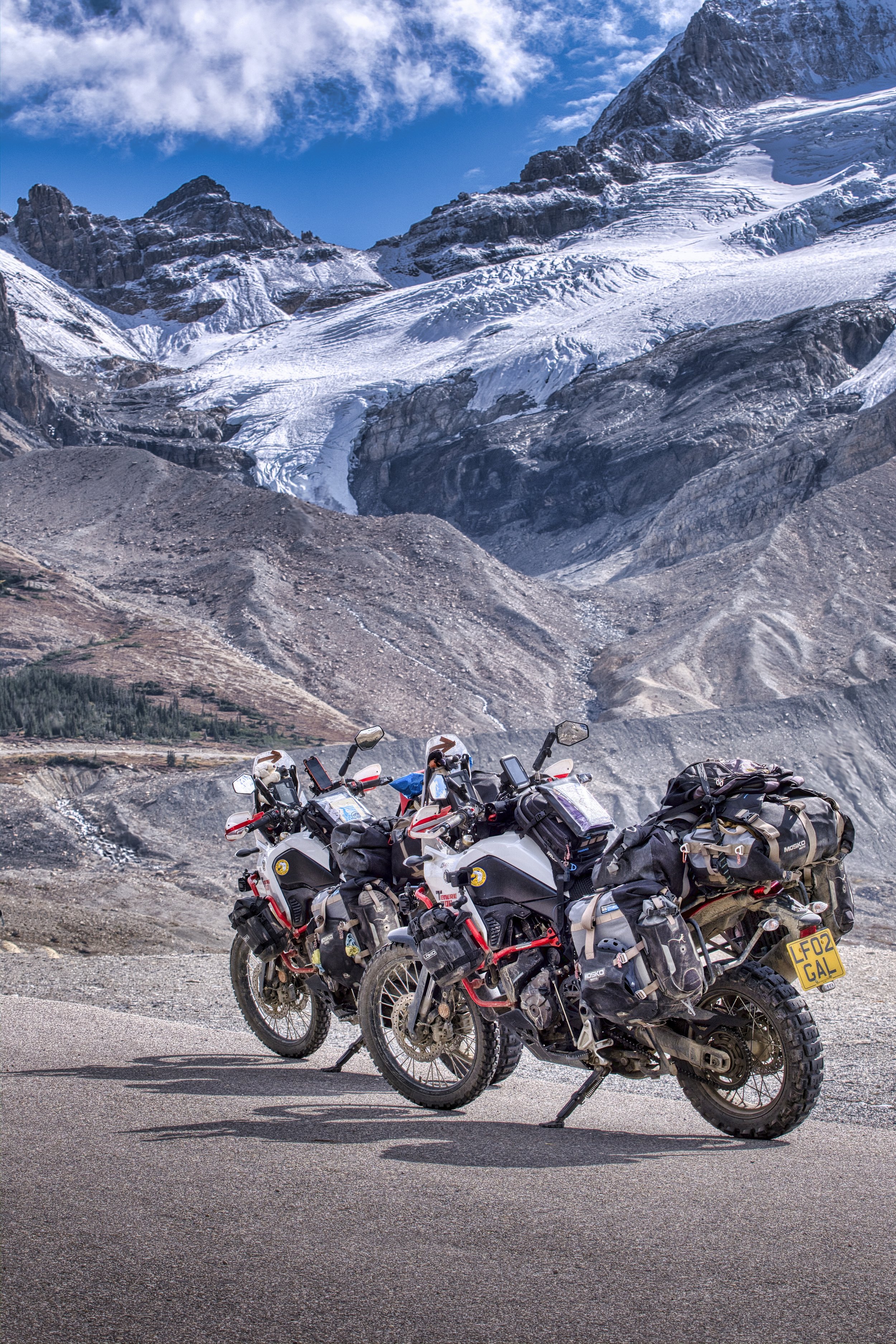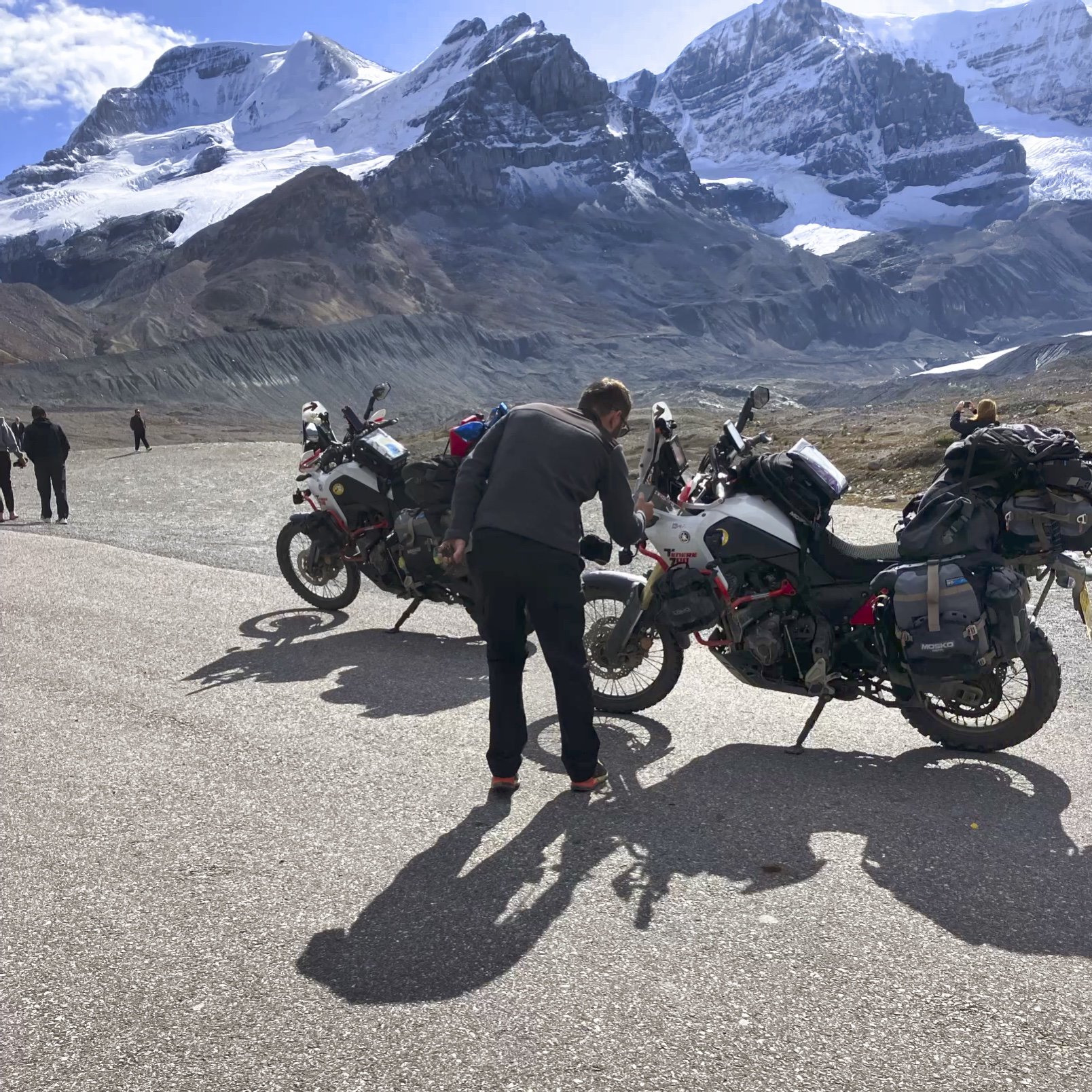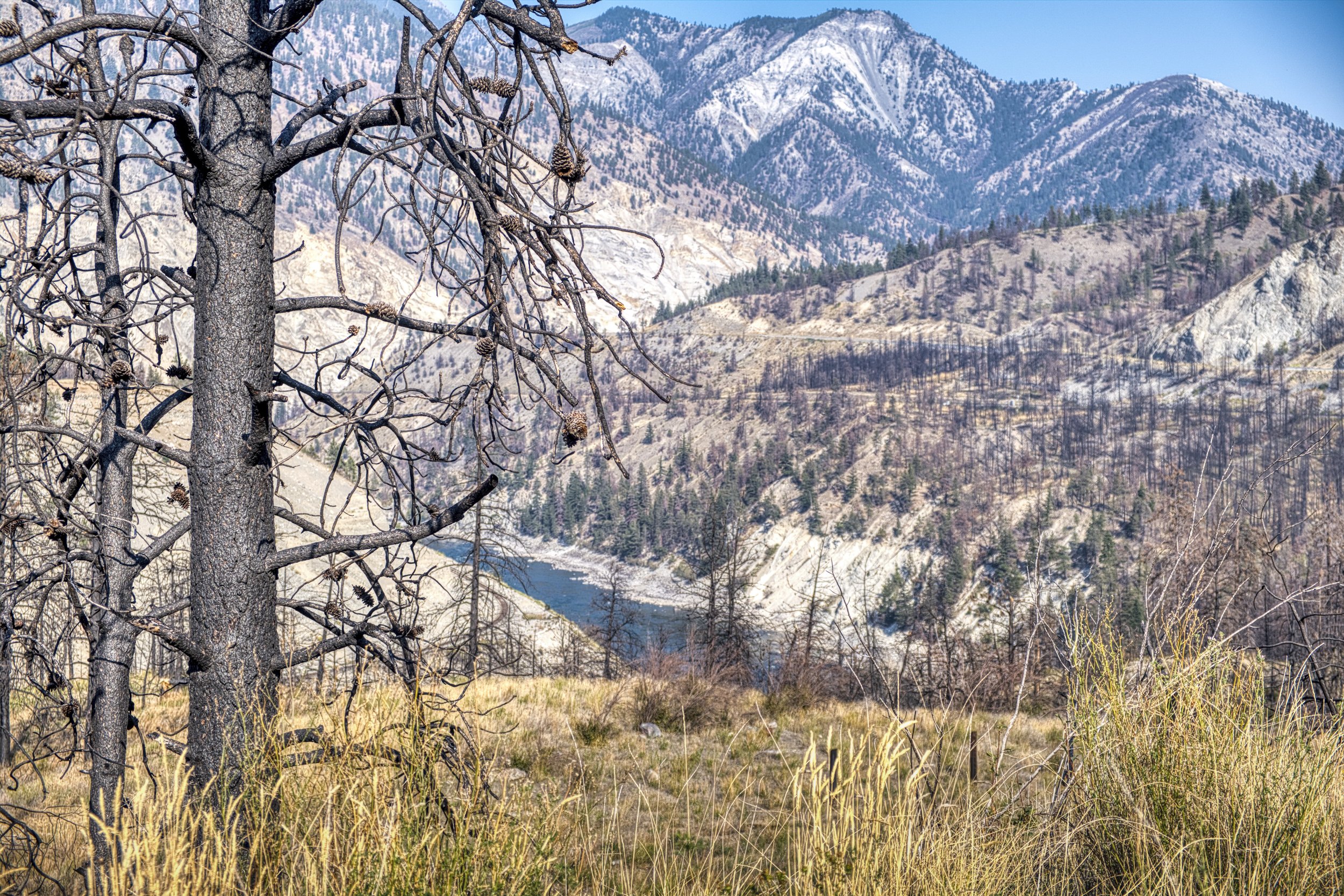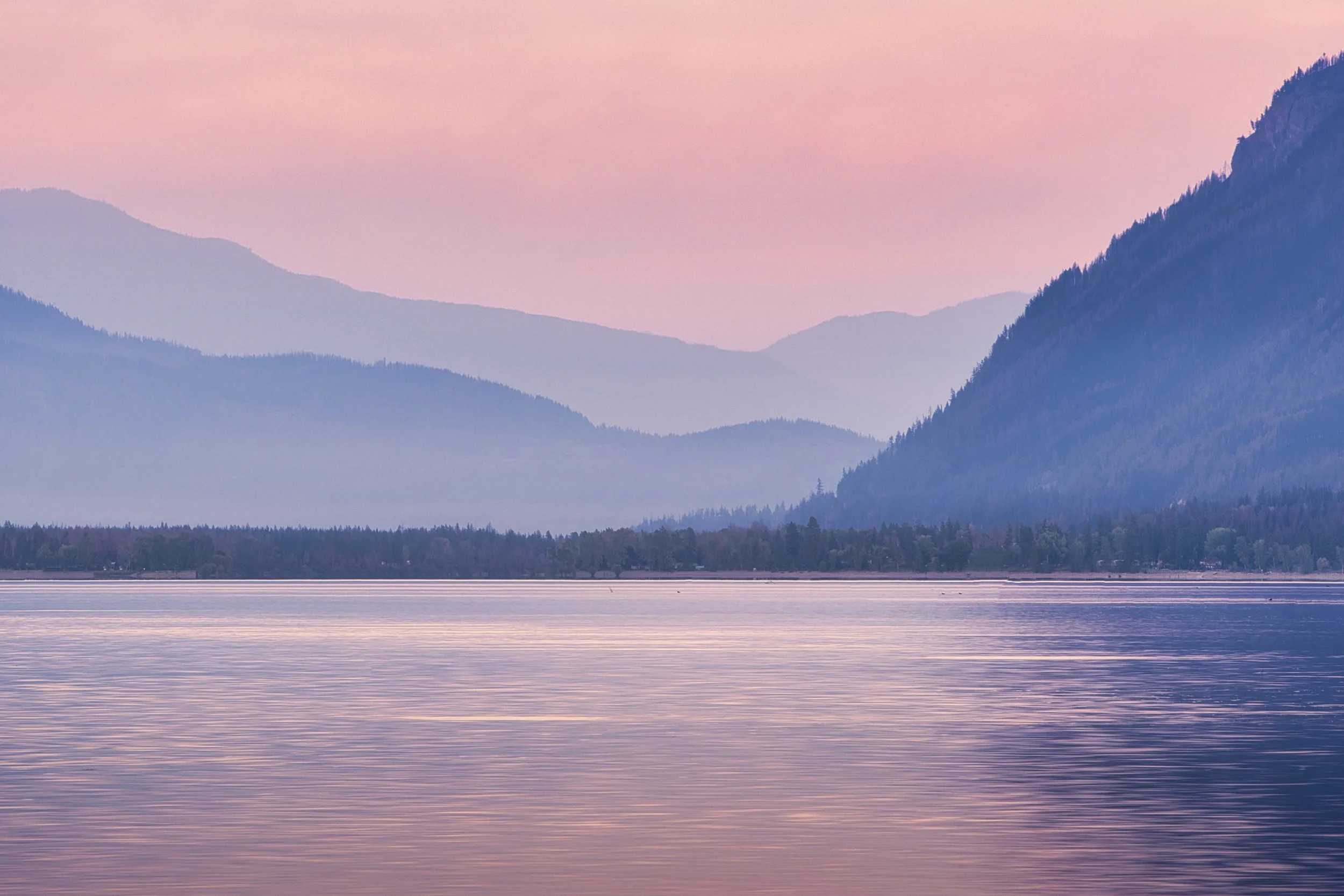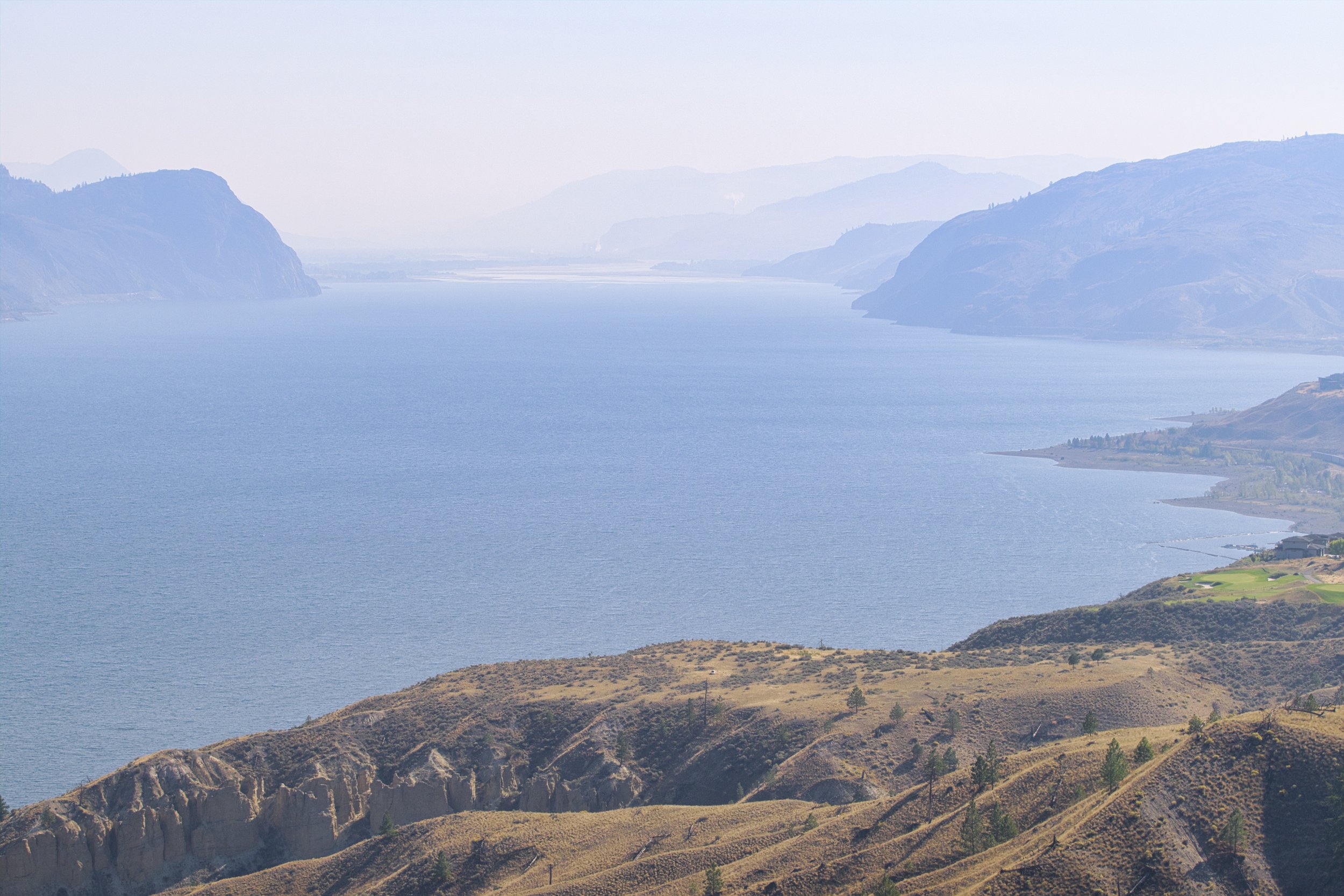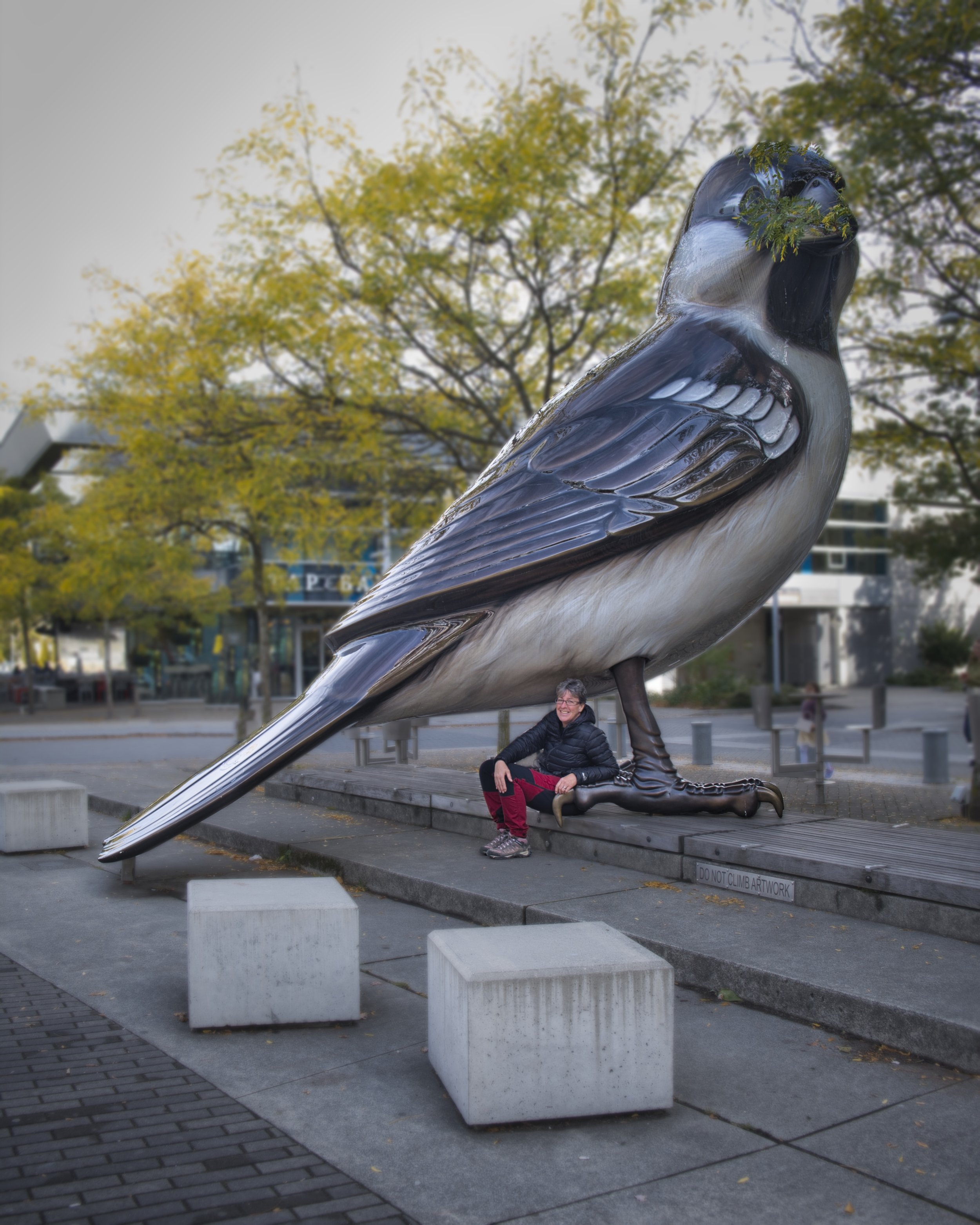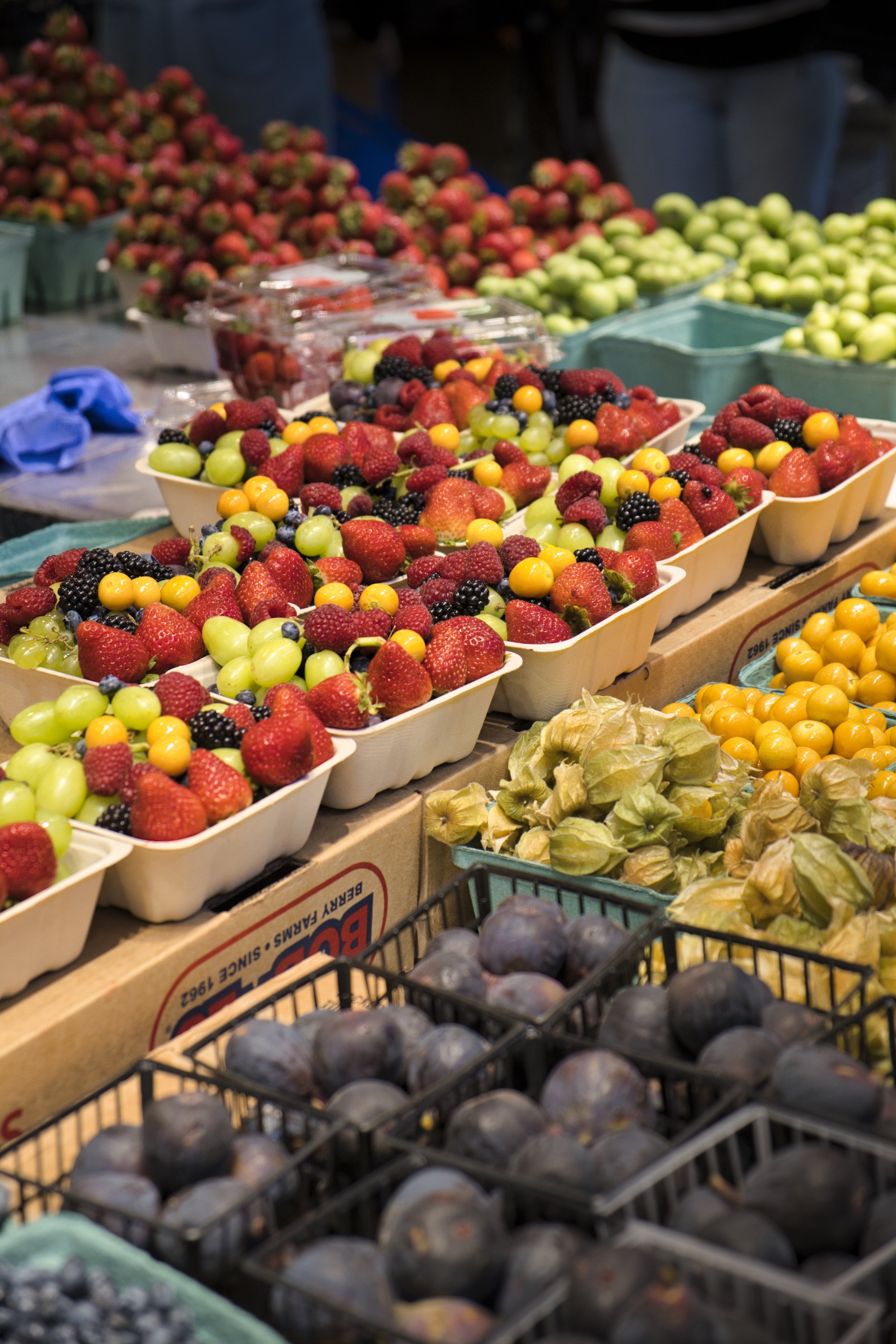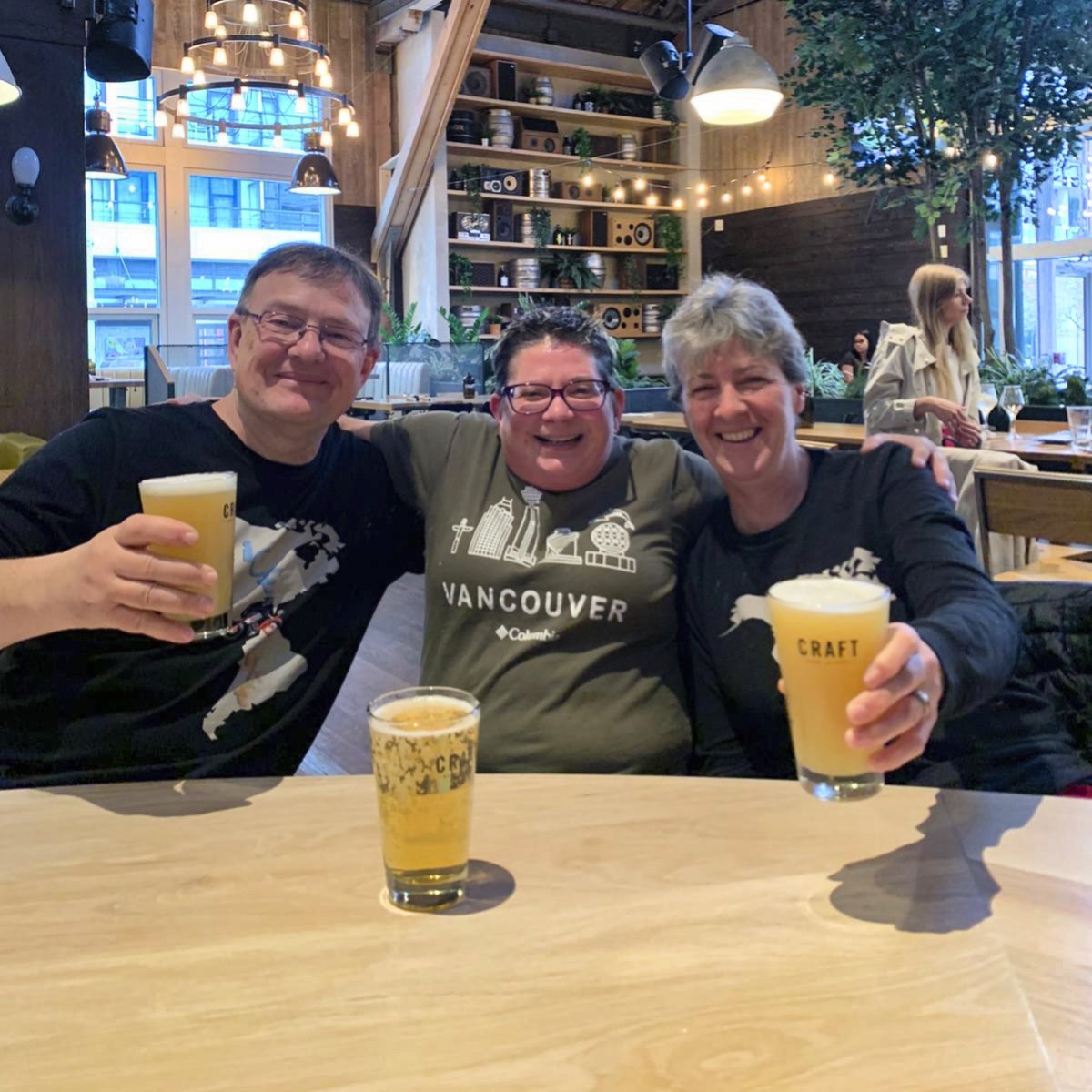What are we doing?
Once again, we were heading through landscapes we had only seen in geography books and social media, but now we’re seeing it, feeling it, smelling it, tasting it and hearing it for ourselves. This was something that no 2D image can make you feel, no matter how good the content producer is. This was for real and we we were living it!
The smell of mountain air quickly replaced the smell of fresh pine as we left the campsite and the fallen tree. The road turned South with the sun warming our faces as it appeared from behind the broken cloud. The temperatures would climb and fall as we moved from one shadow to another or in and out of low cloud still clinging to the forested sides, defying the suns attempts to burn them away. With the occasional stop to view ‘yet another glacier’ or the glacial run-off rivers, we slowly climbed toward the pinnacle of the day - the Icefields Parkway, the Snow Dome and the Athabasca glacier, being the easiest to reach.
Taking a rest
What’s a bit of cloud going to do to spoil a view…
The colour splash.
Peeking through.
Hanging on.
The Snow Dome is the Continental Tri-point watershed, where the Athabasca flows to the Arctic Ocean, the Columbia to the Pacific and the Saskatoon to the Atlantic. As someone suggested, climb to the top with your sledge and point to whichever ocean you would prefer (though the sledge would soon stop as the glacier stops).
That watershed moment.
Photostop
We parked our bikes up to marvel at the scenery and, as is becoming the norm, we became a side-show attraction with people wanting to know where our plates are from, where we had been and where we were heading. One such man wanted to use our bikes as a part of his photo and, of course, we obliged and started the usual conversation that culminated with him returning with his girlfriends phone to capture the QR code. We mustn’t complain but all these interactions do have a negative side as it can take ages just to move on to the next stop!
Snap!
As we reached the pass and the best view of the Athabasca glacier, we remarked on how busy it was (for out-of-season), with the hotel doing a roaring trade and the tours down to and on to the glacier itself. We both started feeling somewhat uneasy at the commercial exploitation of the natural marvel. We took the track leading to the carpark where you could then walk to the foot of the glacier. I was not up for walking that far and on such an uneven surface, but wanted Isi to go, should she desire. The carpark was full and uneven, so finding a suitable place to park the bikes was a problem but even if parking was easy, Isi was feeling more uncomfortable about causing further harm to the glacier even with a single touch, so we turned away.
All this was ice…
As we rode back up the track, we noticed markers with years printed on them and realised they represented the glacier retreat since before the Second World War. It was frightening to realise the glacier had retreated well over 0.5 mile (estimated using Google Maps) in our lifetime and over 1 mile in the lifetime of our parents. At this rate, the glacier will have disappeared within the lifetime of our grandchildren. Whilst I do subscribe to the notion that glacier retreats have been ongoing since before humans walked the Earth, it is the rate of retreat since the industrial revolution that is frightening and yes, we do accept the irony of our concerns, having flown and ridden to this spot to have had these thoughts…
Glacial meltwater
Increased flow from many glaciers.
As these thoughts were processed and discussed, we noticed special coaches ferrying people on and off the glacier, so those able to pay could get up close and personal. We wondered what the glacier would say if it were able to show and express its emotions. Would it be like the Sloth that tolerates the bacteria that infests its coat whilst watching its habitat being destroyed. We felt saddened and somewhat ashamed for the impact we and our fellow parasitic humans were having on this (and other) marvels of nature. At one point, we even questioned our continued adventure but quickly reconciled our carbon footprint now, compared to our life before we started. Putting aside the initial flight, we reckon our day-to-day footprint is probably less now (though the increased use of single-use plastics, enforced upon us, may not make us as clean as we would like to feel).
I mean, what harm can it do, right?
And so the road continued down, away from our concerns of commercial exploitation and back in to our bubble of oohs and ahhs as the scenery continued to excite our senses around every corner. Finally, we fell upon the The Crossing Resort at the Saskatchewan River Crossing and we took a break - a plate of fries (never say chips!) and a hot chocolate. Isi commented that even at a self-service counter where sales interaction was limited to a grunt from the person behind the till, she was still faced with a choice to add a tip or not - the guilt trip is real in North America where tips are the expected norm and not associated with exceptional service. A tip was not left.
And so the ice recedes.
We were both tired after the mornings excitement with the tree and Isi was claiming to be a danger to herself if she rode on any further and, to be fair, there was a history of nodding off to sleep whilst riding. I could tell how serious she was when she volunteered to go and ask reception if they had a room and how much. The answer was yes and $320CAD! Isi’s further justification is that we had effectively had 3 nights free camping and the refund meant the room rate was actually rather reasonable. The argument didn’t cut the mustard with me but I agreed anyway.
So, for $320CAD, we could only get wifi in the bar and the only way to get online was to spend the evening at the bar - what a great way to exploit your customers even more! Having had my fill of social media and the catching up wifi can provide, I was ready for bed. However, Isi didn’t want to remain in the bar on her own, was not ready to go and didn’t want to face the chance I would fall asleep and not hear her knocking at the door - the establishment had only provided one key. I stayed, fighting sleep (and snoring) until ready to go.
The following morning, I woke in a bad mood that wasn’t helped by the complex staff purposely avoiding eye contact and generally acting very miserably - this was not a happy place to work and the feeling had rubbed off on me and probably other guests too. The management have some serious work to do - attitude is driven from the top and the top were failing the staff who are employed to serve the customers. Even dropping the key off at reception was not a joyous experience, with the receptionist barely registering the act. I was happy to leave the toxic environment behind.
The day remained dry but the chill was in the air as the temperature struggled to rise above 4C all day - we had to fly South and follow the geese and the many Canadians who also choose to flee the snow. Heated jackets plugged in and we were off to marvel at yet more British Columbian landscapes and heading for Lake Louise, determined to get some miles done and meet our desire to spend time with Tera in Vancouver within a reasonable timescale. However, every time Isi upped her jacket power setting to high, the fuse would blow and she would have no heat at all. With the Hex Innovate EzCan, this was not a major problem as a restart of the bike also reset the electronic fuse and power would return - until Isi put the jacket to high. With the cold, Isi could not continue riding long-term on medium heat, so we agreed to change the fuse rating when we reached Lake Louise.
Lake Louise was yet another tourist honey-pot and our memory is not one of sweet roses and majestic views. We found a parking spot in the middle of the busy cafe/shop/gift area and proceeded to take the bikes apart - mine to access the laptop and Isi’s to get under the seat. The Hex Innovate ExCan is a simple piece of kit, with a micro USB connection one end of the ‘box’ that you plug in to the laptop - plug ’n’ play at its simplest. Easy operation, you would think, but my laptop decided now was the time to fail - the screen did not light and the keyboard seemed unresponsive. After numerous attempts at rebooting and expletives uttered, we gave up. Isi had to find a wifi signal (coffee time) and download the software, so we could access the box on her laptop. This turned out to be a quick and easy solution, and Isi changed the electronic fuse rating to match mine (the XXL jacket is known to draw more power, so I had already increased the fuse rating).
Is there anybody in there?
Such a simple job!
I was not a happy bunny…. We both hate tech with a passion - when it breaks! How can something built from logic remain so illogical to us, yet simple to others. When the tech fails, a dark and heavy cloud descends upon me, clearly visible to others had they chosen to look. We spent ages trying to find a solution on Google and then looked for a local repair solution - the nearest (and highly rated) was an hour away, in the wrong direction and straight down the Trans Alaska/Canada highway. Despite all the negatives, we set off and 1 hour later, we were in Don’s basement where he diagnosed a screen connection failure as this year of MacBook is known for weak connections and cables. He pressed a few buttons and the screen sprung to life. We left feeling happy but in the full knowledge that the problem could return again and, if so, the most likely solution is a replacement. I now treat the hinge with the same respect as I does pulling my zipper up…
It was time to find a place to pitch the tent. There was a campsite on the outskirts of Canmore, shaped like a triangle with the town, highway and rail line on each side. The RV’s were well catered for with hard standing, power and water, albeit they were close packed. Tents, however, where within a largish thicket of trees and bushes. The pitch sites were small, uneven and bare mud. There were some tents that looked as if they had been there for many weeks or months and the whole feel of the place was not right. When I returned to the bikes, we both agreed we needed to find somewhere else. Neither of us felt comfortable at this place.
Just 20 minutes back up the highway, we found the Tunnel Campground that was a Banff National Park run campground, just outside the town of Banff. The feeling of the place could not be any different. There wasn’t much privacy but the facilities were good and the other campers were friendly. Free wood was available, albeit you had to collect it, so off I went. It turned out to be further than I thought and as I emerged from the undergrowth, following a shortcut, a young man offered me a lift back in his van, with wood aplenty. Another camper came over and offered their splitting axe so I was able to keep Isi warm and happy - always a good state to maintain.
We argue over the smallest of things and the smallest of things become big things, like who last used a cable that was now missing. According to Isi it was my fault and according to me it was Isi’s fault. We finally agreed to share the cable and added a new cable to the shopping list.
The plan for that day was to make as much progress as we could towards Vancouver. We soon found out that this wouldn’t be easy, as the road we intended to use was closed and a 100 kilometre diversion was required. As we have come to expect, the views are always spectacular, regardless of the road and, as we dropped elevation, the temperature rose as did our spirits. The mountains started to give way to managed farmland made green from intensive irrigation and dwellings with manicured lawns.
The scenic diversion took us past Radium Hot Springs. Well known and respected but, to us from the outside, it looked more like a health resort and not the type of hot springs we would favour. The town itself was very quaint, with mountain goats roaming the roads and a man asleep on a bench overlooking the valley below. He was memorable for being clothed in a bright yellow motorcycle rain-suit and wearing a full-face helmet. We initially thought it was a dummy, until he moved slightly before carrying on with his slumber. We found a small independent cafe and enjoyed a bowl of curry soup that ranks up there with the best we have eaten.
If Carlsberg made diversions…
That night, we pitched in a campsite on the outskirts of Golden on a fairly deserted campsite. That was until a young couple pitched right next to us and proceeded to assume that no-one else existed.. Neither had any respect for anyone else’s peace, as they shouted to each other, one in the tent and the other in the car both when they pitched and broke camp at 5.30am the next morning. Other than the couple, my memory of this site is listening to the trains as they pulled their wagons out of the sidings and in to the gorge, sounding their horns as they passed the campsite and left the town. They were noisy but, to me, such a lovely sound.
Isi started the next day with a meltdown. Her back and knees were hurting and the cold was not helping. It had dropped below freezing during the wee hours and the high walls of the gorge prevented the bright sunshine from adding warmth to our aching bones. We then noticed that Isi’s hand guard had come loose, probably from the fall near Skagway, but now we had noticed we had to do something about it. Whilst one screw was able to gain good grip on the aluminium bar, the other would not, so we resorted to tried and tested cable ties. As a temporary measure it is still going and will prove interesting to see just how many videos these cable ties will continue to appear in.
“It just fell off”. Hmm…
After a late start, we left Golden and headed up in to Rogers Pass in the Selkirk Mountains. A triumph of the Trans Canada Highway, the pass is approached via 5 long tunnels that open in to a bowl surrounded by mountains, with just a valley indicating your exit. The pass was named after Major A.B. Rogers, who discovered the pass as a suitable point for the Canadian Pacific Railroad Co. to pass through the high mountain range. As you would expect, the conditions of work were hard but made even harder with money running short and workers working months with no pay. The railroad construction costs were cut to the bone, with very few avalanche sheds (half tunnels built to keep avalanches from swallowing the tracks) being built, ballast not being applied between the sleepers and bridges built of green timbers, sawn to a very minimum width. Whilst the dangers of construction were increasing with the reduction in available funds, the many avalanches were taking their toll on lives as buildings were swallowed by the snows.
At the top of Rogers Pass, there is now a memorial to commemorate the efforts of the many workers that lost their lives to the construction of the railway, and an artillery gun to show how the avalanches are controlled with explosions causing avalanches, keeping the highway and railway open. The Canadian Parks still use the same techniques today, to keep the pass open and safe. The memorial is a simple bell that you are encouraged to ring, surrounded by representations of the various workers who lost their lives. The floor is gravel, with a pronged rake to one side. After ringing the bell, you are required to rake the ground, removing the trace of your feet just as the snow erased the lives of the lost souls. The very act of sweeping away the steps provided the time to reflect on the lives lost and the cost to further mans exploitation of the Canadian interior.
As the avalanche erased the souls, so the rake erases the soles…
It was here that we also saw the men and machines that “stitch” the roads up by filling the mini cracks with liquid tar. Interesting machines but what a soul-destroying job in such a beautiful place. We now look at the snaking tar ribbons with a renewed knowledge of how they are done and the time taken.
Coming down from the Pass, there were many areas where the summer wildfires had passed through, leaving havoc in their wake. Road repairs were still underway and telegraph poles still being replaced. Buildings and vehicles were either left as charred hulks or in the process of being repaired or cleared away. When we had been travelling further North, we had heard of many roads being closed and we were seeing the aftermath as we passed through the mountains to the valley below. Numerous times, we could see and smell smoke from fires still being fought or fires recently brought under control but leaving the acrid, tarry smell of burnt pinewood.
Survivor
There be gold in them hills…
Smoke in the mountains
And so we dropped to the valley floor where agriculture and well maintained gardens replaced the rough mountains of rock and pine. Around this time, Isi felt tired and we suggested a stop. Just as in Norway, Isi stopped, put the side stand down and fell asleep but the different helmet didn’t prove as comfortable, so Isi quickly migrated to a nearby picnic bench and fell asleep using gloves as a pillow. Unlike Norway, this particular stop didn’t inspire the use of the camera, so I started fettling with the bikes and watched an eagle chick high in the trees, calling for Mum & Dad. Having fettled to satisfaction and joining the chick in the hope of a parental return, I took to iOverlander in search of a campsite for the night.
Once Isi was awake enough to get back on the bike (it can take a while), we headed to a small site in Chase, adjacent to the Little Shuswap Lake and the South Thompson River that feeds it. Right at the end of their season, the site was worn but comfortable enough. It was a delight to watch the fishermen, either by boat or foot, chasing the ever-jumping river trout and salmon. An added bonus was the sunset with the colours amplified by the smoke lingering in the distant valleys that encouraged me to get out the tripod for the first time in the trip and lose myself in the art of photography.
Chase and the smoke
Makes a nice sunset
That evening, Isi sat in the tent writing her journal notes while Carl was outside in the dark, cooking a curry for tea. Isi was in tears. She knew we had to get to Vancouver but she was struggling with the the longer rides and the camping day after day. We were taking rest days but there was always pressure to get to the next place. This was taking a toll on both our physical and mental healths and causing us to argue over the slightest of things. We can’t help but wonder what it is we are doing and why we are doing it. Life on the road is hard with daily challenges and fleeing from the cold and the snow.
After having the site owner kindly switch off the generator of the empty RV parked within 30 feet, we settled in for a cold dark night listening to the fish jumping in the river just below us.
Then the scenery changed again. From irrigated, green fields of crops, to dusty oranges and brown interspersed with dried out ponds of a white salt and bright red margins. As these ponds do not have an outflow, the salt content builds up over many, many years, fed only by rain, groundwater and snowmelt. As the water evaporates it leaves the salt behind, ready for the next hydration. The red margins are a species of brine shrimp that have adapted to the very high salt concentrations that reduces the oxygen within the water. The shrimp produce higher amounts of haemoglobin and, in vast numbers, make the pond margins appear like blood against the white salt.
We had entered the Kamloops region and one of British Columbia’s deserts. A very distinct change in scenery and one we both imagined Arizona may look like. The brown landscape was interspersed with pockets of green, irrigated farmland and numerous golf courses. At a viewpoint overlooking the Kamloops Lake, you could see a new development of plush houses surrounding a green golf course - nice for the people that choose to retire there but not in-keeping with the landscape of the area. It must have taken a lot of money and ‘influence’ to gain the agreement to build this development. We had stopped for a quick break and a few photos before cracking on with the day. However, we ended up chatting to Nigel and Sue from Shropshire and a 10 minute stop turned in to 45 minutes. I’m not complaining at all, as the people were very nice and easy to talk with, just another example of how our bikes can delay our movement. Oh, and there were signs in the car park warning of rattle snakes - not something we had expected in Canada!
Steamboat Saga
Kamloops desert
Kamloops Cairn
Kamloops lake with smoke
Another long day and we were nearing our intended stop for the night - a campsite just before Hope. We saw a gas station and decided to fuel that night to get a good start in the morning. We pulled up behind two BMW bikes that had just filled up and instantly got chatting. Jonathan and Lisa were extremely friendly and useful with their advice on what border to use when entering the USA. We filled the bikes and carried on chatting, only interrupted by the garage owner politely saying she needed to shut up shop and would we mind paying…
The campsite was literally across the road and over the rail tracks. A pretty site in amongst big pine trees either upright and growing or having been felled and left for nature to recover. The tent pad was a fine shingle, larger than sand but small enough to be likened to crushed seashells. Not a problem for pitching or sleeping but proved a substance that would stick to the tent in the morning. Overnight it rained heavily, with the sound of the raindrops only interrupted by the trains horns blaring their arrival at the level crossing. When morning arrived wet and cold, we could hear a train engine idling on the tracks beside us. We thought nothing of it until advised that flooded tracks had caused the trains to stop running and the train had stopped across the level crossing - we were trapped! However, one of the advantages of being slow in the mornings is that the train blockade had cleared by the time we left but, unfortunately, the rain continued.
We were cold and wet and in search of food and coffee, neither of which proved easy to find. Finally we settled on a Tim Hortons and vowed we would not be in any rush to visit another.
Then it was time to navigate the city streets of Vancouver. I tend to use Calimoto for most of our riding, as it looks for twisties and avoids built up areas. It will obviously navigate to city locations but the interface is not designed for multiple lanes or roadsigns. Isi has the TomTom that is far better designed for cities but she does not like to take the lead in busy traffic. Trying to follow Calimoto, I got in the wrong lanes and crossed to the wrong side of the river and turned a 30 minute ride in to something well over an hour. But, with Isi eventually leading we made it and found Tera’s apartment.
Before I provide a brief update on the visit with Tera (what’s said in Rome, stays in Rome!), I must explain how we came to meet her. In 2019, we were riding our bikes around Ireland, loosely based on the Wild Atlantic Way. One night we stayed in a castle and whilst all the residents were individuals, couples or small groups, we were treated as a large group with ‘champagne’ and a talk by our host, before heading off to the dining hall. This broke the ice and people talked to others they had never met. After dinner, we retired to the bar and this is when a larger than life lady bounced across the floor and shouted “Hi, I’m Tera from Canada, can I join you?”. Well, what could we say? Of course you can, and so a friendship was formed. A single night in a far flung country four years ago had led to this day and the friendship was as strong as it was before.
Tera wanted to show her city to us and we headed down to the harbour to catch a river bus to Stanley Park out at the end of the estuary. We say river bus but it seemed like something I remember building to do the Rye raft race, strapping oil barrels under planks of wood held together with rope that loosened their knots as they got wet. But this was the way to travel and fun and laughter flowed at all and every opportunity! The number of passengers was limited to around 20, so it felt intimate and fun. At one point, our river bus was approaching another, mid river and with beeping of horns, the two boats circled each other in a kind of dance, much to the enjoyment of both skippers and their passengers!
The river front
At least it has a proper hull.
Such innocence in those eyes….
Toy town?
Are those beer barrells?
Nesting
When
in
Rome
After lunch and a foray into the street market, I needed to pee and took the steps leading to the public washroom. It was not clear what gender toilet it was but passing a man on his way out, I figured I had it right. The lack of urinals or the Tampax vending machine on the wall did not slow me down in the dash to a cubicle for relief. It was only as I was washing my hands and generally chatting to the lady stood next to me, that I realised I was in the Ladies. This realisation was quickly followed by the raucous laughter of Isi and Tera standing outside with camera ready to record the exit. Let’s just say, I owned it, with a trip down the step as I made a prompt exit…
Whoopsie
Is there a problem?
The other side of the harbour
The harbour
Patriotism
So much fruit!
The fruit market
Driftwood
Having returned back to the car, Tera took us on a tour of the less desirable side of the City. Hastings is a main road in the City that is frequented by a hundred or more people down on their luck, living on the street. Many showing the effects of substance abuse and some trying to sell whatever they could. Whilst an embarrassment to the City, we couldn’t help but feel sorry for the impact of decisions (conscious or otherwise) that had led to this life and wonder how many will manage to break free from the poverty trap that such a life envelopes them in.
After a few more days of fun and shopping (we bought a replacement cable), it was time to move on. Another short and intense few days with a friend whom we struggled to say goodbye to and hope to meet again someday soon.
Cheers!

